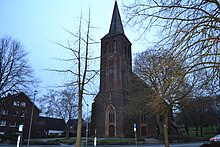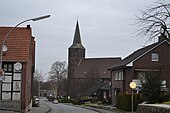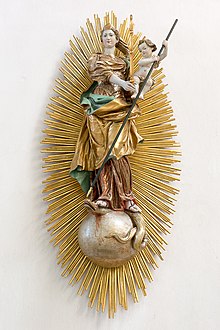St. Margaretha (Ostenfelde)
St. Margaretha is a Roman Catholic parish church in Ostenfelde , a district of Ennigerloh in the Warendorf district . ( North Rhine-Westphalia ). The church and parish belong to the Beckum deanery in the Münster diocese . The church is subordinate to the patronage of St. Margaret of Antioch.
Building history
The previous church from the 11th century was a little away on Margarethenplatz. Like today's, it formed the center of the village. It was canceled in 1859. The quarry stones were reused, they were used for the construction of the two peasant chapels on the Schürenbrink and the Dromberg. The previous chapels had become dilapidated.
After the old church was found to be in disrepair, the administrative district of Münster initially permitted a house collection on December 2, 1854. There was already talk of a new building instead of a renovation. The district administrator of the Warendorf district spoke out against the permit on January 24, 1855, as he considered repairs to be sufficient. However, he saw that the church was too small for the 1637 Catholics. Thereupon the collection was finally rejected. The community, considered to be wealthy, was instead asked to raise a fund with 12,000 thalers. The neighboring churches should be visited until the church is renewed. In 1855 the municipality made the fund available by raising capital. Despite reservations by the district administrator, who did not wish to raise capital, a collection was approved by the chief president of the Münster administrative district. It brought in 4752 thalers 22 Sgr. 9 Pfg. In the years 1860–1861 Emil von Manger built the new building. After its completion, the old church on Margarethenplatz was demolished.
Building description
The neo-Gothic three-nave hall church was built in bricks on a natural stone base. It is 37.50 m long, 17.50 m wide and the tower has a total height of 51.97 m. The nave extends over four bays, to which the choir adjoins via two lower bays. To the north of the choir is the sacristy. A gallery with separate access was built for the family members of the Vornholz house, and a crypt was added for the family, in which the coffins from the old church were reburied and afterwards deceased members of the family found their final resting place. The coffins are housed in locked niches.
organ
The organ was built in 1939 as a cone chest instrument by the organ builder Anton Feith (Paderborn). Some registers of the previous instrument from 1864 ( Carl August Randebrock , Paderborn) and the existing case were reused. The side pedal towers and the standing flat springs that are connected to the towers were added to the main work. In 2010 the instrument was extensively restored. The organ builder Sauer carried out the work in which the instrument newly adopted was. The organ has a total of 1730 pipes; the smallest is 8 mm and the largest is 2.50 m high.
|
|
|
|||||||||||||||||||||||||||||||||||||||||||||||||||||||||||||||||||||||||||||||||||||||||||||||||||||||||
- Coupling : II / I, I / P, II / P; II / II and I / I as sub and super octave couplings, I / P as super octave couplings
- Annotation:
- R = register by Randebrock (1864)
Furnishing
- The Radiant Madonna, the baptismal font and the late Gothic altar cross come from the previous building
- The octagonal baptismal font is decorated with tracery and dates from around 1500
- The Marienglocke was cast in 1738 and was taken over from the old church. It is the second largest bell of the peal and is tuned to the note e. During the Second World War it had to be given in for war purposes and in 1947 it was fetched unharmed from the Hamburg bell cemetery.
- The Margaret Bell is the largest bell. It is tuned to the c sharp note.
- The Joseph Bell is tuned to the tone f sharp and it is the second smallest bell.
- The angelus bell is tuned to the tone G sharp.
- The carved and mounted crucifix is a work from the end of the 14th century.
literature
- Jörg AE Heimeshoff : The master builder Emil von Manger . Bonn 1982, ISBN 3-7749-1902-X .
- Church leader St. Margaretha Ostenfelde HrsG. : Parish office St. Margaretha, Ennigerloh Ostenfelde
- Dehio, Georg , under the scientific direction of Ursula Quednau: Handbook of German art monuments. North Rhine-Westphalia II Westphalia . Deutscher Kunstverlag , Berlin / Munich 2011, ISBN 978-3-422-03114-2
Individual evidence
- ^ Dean's office and diocese
- ↑ Church leader St. Margaretha Ostenfelde HrsG. : Parish office St. Margaretha, Ennigerloh Ostenfelde page 3
- ↑ Church leader St. Margaretha Ostenfelde HrsG. : Parish office St. Margaretha, Ennigerloh Ostenfelde page 3
- ↑ Church leader St. Margaretha Ostenfelde HrsG. : Parish office St. Margaretha, Ennigerloh Ostenfelde page 3
- ↑ More information about the organ
- ↑ Church leader St. Margaretha Ostenfelde HrsG. : Parish office St. Margaretha, Ennigerloh Ostenfelde page 21
- ↑ Dehio, Georg , under the scientific direction of Ursula Quednau: Handbuch der deutschen Kunstdenkmäler. North Rhine-Westphalia II Westphalia . Deutscher Kunstverlag , Berlin / Munich 2011, ISBN 978-3-422-03114-2 , page 313
- ↑ Church leader St. Margaretha Ostenfelde HrsG. : Parish office St. Margaretha, Ennigerloh Ostenfelde page 3
- ↑ Dehio, Georg , under the scientific direction of Ursula Quednau: Handbuch der deutschen Kunstdenkmäler. North Rhine-Westphalia II Westphalia . Deutscher Kunstverlag , Berlin / Munich 2011, ISBN 978-3-422-03114-2 , page 313
Web links
- City of Ennigerloh: 360 ° panorama of the interior
- Pages of the Dean's Office
Coordinates: 51 ° 51 '54.3 " N , 8 ° 4' 47.9" E




